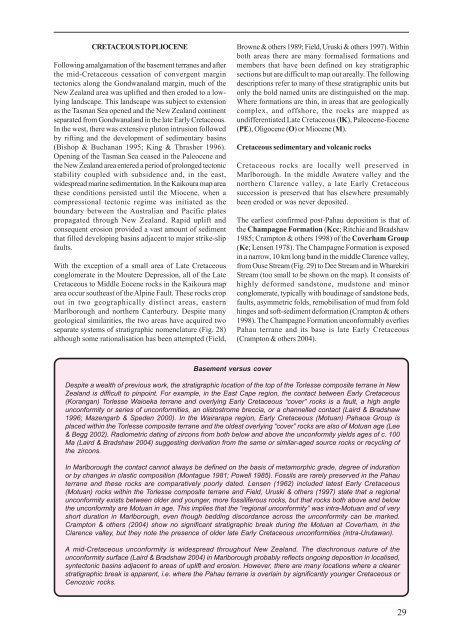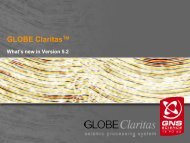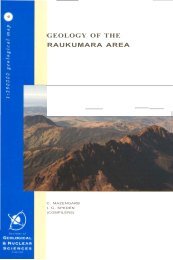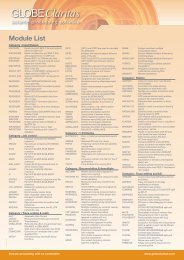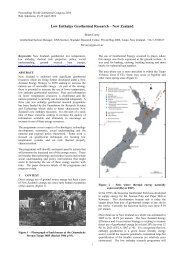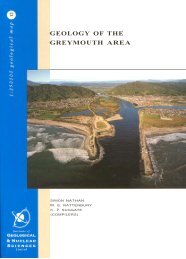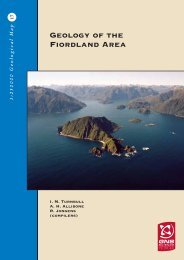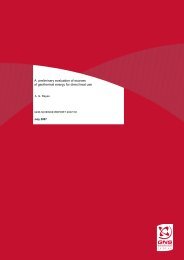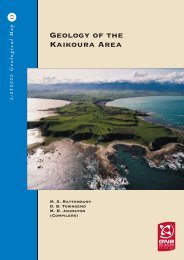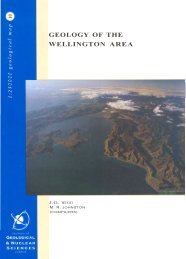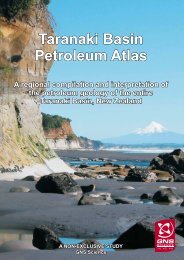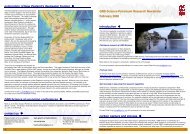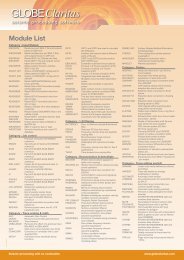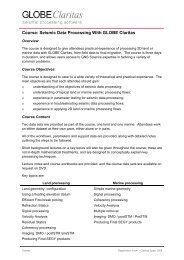Geology of the Kaikoura Area - GNS Science
Geology of the Kaikoura Area - GNS Science
Geology of the Kaikoura Area - GNS Science
- No tags were found...
You also want an ePaper? Increase the reach of your titles
YUMPU automatically turns print PDFs into web optimized ePapers that Google loves.
CRETACEOUS TO PLIOCENEFollowing amalgamation <strong>of</strong> <strong>the</strong> basement terranes and after<strong>the</strong> mid-Cretaceous cessation <strong>of</strong> convergent margintectonics along <strong>the</strong> Gondwanaland margin, much <strong>of</strong> <strong>the</strong>New Zealand area was uplifted and <strong>the</strong>n eroded to a lowlyinglandscape. This landscape was subject to extensionas <strong>the</strong> Tasman Sea opened and <strong>the</strong> New Zealand continentseparated from Gondwanaland in <strong>the</strong> late Early Cretaceous.In <strong>the</strong> west, <strong>the</strong>re was extensive pluton intrusion followedby rifting and <strong>the</strong> development <strong>of</strong> sedimentary basins(Bishop & Buchanan 1995; King & Thrasher 1996).Opening <strong>of</strong> <strong>the</strong> Tasman Sea ceased in <strong>the</strong> Paleocene and<strong>the</strong> New Zealand area entered a period <strong>of</strong> prolonged tectonicstability coupled with subsidence and, in <strong>the</strong> east,widespread marine sedimentation. In <strong>the</strong> <strong>Kaikoura</strong> map area<strong>the</strong>se conditions persisted until <strong>the</strong> Miocene, when acompressional tectonic regime was initiated as <strong>the</strong>boundary between <strong>the</strong> Australian and Pacific platespropagated through New Zealand. Rapid uplift andconsequent erosion provided a vast amount <strong>of</strong> sedimentthat filled developing basins adjacent to major strike-slipfaults.With <strong>the</strong> exception <strong>of</strong> a small area <strong>of</strong> Late Cretaceousconglomerate in <strong>the</strong> Moutere Depression, all <strong>of</strong> <strong>the</strong> LateCretaceous to Middle Eocene rocks in <strong>the</strong> <strong>Kaikoura</strong> maparea occur sou<strong>the</strong>ast <strong>of</strong> <strong>the</strong> Alpine Fault. These rocks cropout in two geographically distinct areas, easternMarlborough and nor<strong>the</strong>rn Canterbury. Despite manygeological similarities, <strong>the</strong> two areas have acquired twoseparate systems <strong>of</strong> stratigraphic nomenclature (Fig. 28)although some rationalisation has been attempted (Field,Browne & o<strong>the</strong>rs 1989; Field, Uruski & o<strong>the</strong>rs 1997). Withinboth areas <strong>the</strong>re are many formalised formations andmembers that have been defined on key stratigraphicsections but are difficult to map out areally. The followingdescriptions refer to many <strong>of</strong> <strong>the</strong>se stratigraphic units butonly <strong>the</strong> bold named units are distinguished on <strong>the</strong> map.Where formations are thin, in areas that are geologicallycomplex, and <strong>of</strong>fshore, <strong>the</strong> rocks are mapped asundifferentiated Late Cretaceous (lK), Paleocene-Eocene(PE), Oligocene (O) or Miocene (M).Cretaceous sedimentary and volcanic rocksCretaceous rocks are locally well preserved inMarlborough. In <strong>the</strong> middle Awatere valley and <strong>the</strong>nor<strong>the</strong>rn Clarence valley, a late Early Cretaceoussuccession is preserved that has elsewhere presumablybeen eroded or was never deposited.The earliest confirmed post-Pahau deposition is that <strong>of</strong><strong>the</strong> Champagne Formation (Kcc; Ritchie and Bradshaw1985; Crampton & o<strong>the</strong>rs 1998) <strong>of</strong> <strong>the</strong> Coverham Group(Kc; Lensen 1978). The Champagne Formation is exposedin a narrow, 10 km long band in <strong>the</strong> middle Clarence valley,from Ouse Stream (Fig. 29) to Dee Stream and in WharekiriStream (too small to be shown on <strong>the</strong> map). It consists <strong>of</strong>highly deformed sandstone, mudstone and minorconglomerate, typically with boudinage <strong>of</strong> sandstone beds,faults, asymmetric folds, remobilisation <strong>of</strong> mud from foldhinges and s<strong>of</strong>t-sediment deformation (Crampton & o<strong>the</strong>rs1998). The Champagne Formation unconformably overliesPahau terrane and its base is late Early Cretaceous(Crampton & o<strong>the</strong>rs 2004).Basement versus coverDespite a wealth <strong>of</strong> previous work, <strong>the</strong> stratigraphic location <strong>of</strong> <strong>the</strong> top <strong>of</strong> <strong>the</strong> Torlesse composite terrane in NewZealand is difficult to pinpoint. For example, in <strong>the</strong> East Cape region, <strong>the</strong> contact between Early Cretaceous(Korangan) Torlesse Waioeka terrane and overlying Early Cretaceous “cover” rocks is a fault, a high angleunconformity or series <strong>of</strong> unconformities, an olistostrome breccia, or a channelled contact (Laird & Bradshaw1996; Mazengarb & Speden 2000). In <strong>the</strong> Wairarapa region, Early Cretaceous (Motuan) Pahaoa Group isplaced within <strong>the</strong> Torlesse composite terrane and <strong>the</strong> oldest overlying “cover” rocks are also <strong>of</strong> Motuan age (Lee& Begg 2002). Radiometric dating <strong>of</strong> zircons from both below and above <strong>the</strong> unconformity yields ages <strong>of</strong> c. 100Ma (Laird & Bradshaw 2004) suggesting derivation from <strong>the</strong> same or similar-aged source rocks or recycling <strong>of</strong><strong>the</strong> zircons.In Marlborough <strong>the</strong> contact cannot always be defined on <strong>the</strong> basis <strong>of</strong> metamorphic grade, degree <strong>of</strong> indurationor by changes in clastic composition (Montague 1981; Powell 1985). Fossils are rarely preserved in <strong>the</strong> Pahauterrane and <strong>the</strong>se rocks are comparatively poorly dated. Lensen (1962) included latest Early Cretaceous(Motuan) rocks within <strong>the</strong> Torlesse composite terrane and Field, Uruski & o<strong>the</strong>rs (1997) state that a regionalunconformity exists between older and younger, more fossiliferous rocks, but that rocks both above and below<strong>the</strong> unconformity are Motuan in age. This implies that <strong>the</strong> “regional unconformity” was intra-Motuan and <strong>of</strong> veryshort duration in Marlborough, even though bedding discordance across <strong>the</strong> unconformity can be marked.Crampton & o<strong>the</strong>rs (2004) show no significant stratigraphic break during <strong>the</strong> Motuan at Coverham, in <strong>the</strong>Clarence valley, but <strong>the</strong>y note <strong>the</strong> presence <strong>of</strong> older late Early Cretaceous unconformities (intra-Urutawan).A mid-Cretaceous unconformity is widespread throughout New Zealand. The diachronous nature <strong>of</strong> <strong>the</strong>unconformity surface (Laird & Bradshaw 2004) in Marlborough probably reflects ongoing deposition in localised,syntectonic basins adjacent to areas <strong>of</strong> uplift and erosion. However, <strong>the</strong>re are many locations where a clearerstratigraphic break is apparent, i.e. where <strong>the</strong> Pahau terrane is overlain by significantly younger Cretaceous orCenozoic rocks.29


